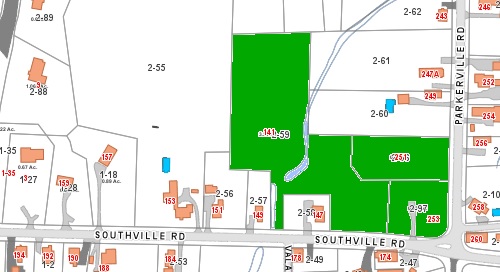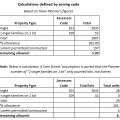Above: If approved, the area of the green parcel west of the stream would house four homes and another four duplexes. (Image cropped and edited from Town’s GIS map)
To the dismay of southside residents, long-neglected Town zoning codes may allow a high density development without the intended upsides.
This week, the Zoning Board of Appeals held a hearing on “Caine’s Crossing at Lincoln Square”. The 55+ housing would put 12 housing units on the corner of Parkerville and Southville roads. The circle would encompass four single family homes and four duplexes.
The permit seeks to take advantage of zoning intended to protect open space and to increase economical options for seniors. But the details of the plan may not do either.
Meanwhile, developer Bartolini Builders* may have to go back to the drawing board if the ZBA finds the project exceeds the limit on the special senior housing zoning. Questions about the limit are what forced the ZBA to continue the hearing. (My math shows that they are only allowed 5-8 units. Scroll down for more on that.) (Turns out my math was wrong – but 12 units still may be one more than allowed.)*
As discussed at recent Planning Board meetings, the elderly development allows zoning relief by easing stricter requirements of a major residential development. It was written to create more affordable options for seniors to downsize in town. Unfortunately, criteria to allow affordability are either vague or unenforcable.
One protection was through limiting the use to non-profit developers. That restriction is purportedly not allowed by state law. Which is why the Planning Board is bringing an article to Town Meeting striking the language.
The other protection, which may not have been enforced by the ZBA in the past, is code specifying:
Evidence shall be shown that, to the greatest extent possible, the development is offering to provide for the needs of Southborough residents of varying economic levels
Jack Bartolini* and his engineering consultant said that the size and density of the the development will make the market-driven costs “modest”. The estimated $400,000 price range would be below average market rates in town.
Bartolini said the Town Planner told him the project would be a good one for the land and meet a Town housing need. And he argued that he was following exactly the same process as for the 190+ units the ZBA previously approved. Assistant Chair Thomas Bhistikul* still wasn’t sure the criteria was being properly met.
However, since another question was unresolved, that issue was tabled when the board voted to continue the hearing.
The other zoning loophole is the open space protection.
A resident commented that the high density project isn’t in keeping with the neighborhood. Bhistikul responded that the density is encouraged in order to protect sections of open space.
But the Assistant Chair admitted that, in this case, the trade-off isn’t a benefit. The “open space” portion is already undevelopable due to wetlands.
Town efforts to revamp zoning codes date back years. The most recent effort at a major overhaul was taken on by the Planning Board, but continually postponed. Eventually, under guidance from the Town Planner, the board sought to revise the code piecemeal.
But even that keeps getting delayed.
Only the stricken language, and not revamped senior housing code, is going to Town Meeting. The only other zoning the board is bringing to Town Meeting is further specifications on the solar bylaw – a new bylaw introduced last year. (The Site Plan Review bylaw was pulled from the Warrant in 2014 on the floor, 2015 prior to the meeting, and not even submitted for 2016.)
And inconsistencies in the existing law continue to plague Town officials. Last night, Planning Board Chair Don Morris and Bhistikul debated the application process. On behalf of the developer, engineer Peter Bemis pointed out that discrepencies between various sections of the code muddy the waters.
As for the continuation of last night’s hearing, the board is seeking confirmation that the 12 units are within the number allotted by Town code.
Bartolini explained that the Town Planner and assessor worked out the math and shared it through the Building Inspector. But the applicant hadn’t included the letter in the application.
The “Over 55 Calculation” posted to the Town website seems to confirm Bartolini’s claim. But it also supports a claim by Sam Stivers that the Planner’s math was wrong.
Speaking as a resident, the Advisory Board member pointed out that the planner calculated 7% of both single and multi-family properties. The zoning code specifies limiting units in Town to % of single family homes:
The total cumulative number of units approved under this section by the Zoning Board of Appeals since January 1998 shall at no time exceed seven (7%) percent of the total number of one-family houses in Southborough at the beginning of the year in which the application is filed, based on the Assessor’s records. Residences containing apartments shall be counted as one-family houses for the purpose of this subsection.
Stivers calculated the town can only allow 8 more units under the special permit. (It may actually be as low as 5 units. But, Stivers made an assumption that the # of 2 single family homes on a lot counted lots instead of homes.)
(I included snapshots of the Planner’s table and 2 versions of the corrected math below. Click to enlarge.)
Stivers urged the board to check, saying if a permit is issued on false assumption, an appeal would be “a slam dunk”.
[Note: I have since realized that “residences containing apartments” is interpreted as being any building with at least one apartment. Therefore, the Town Planner’s calculations were correct. But they have been updated since they were posted on the website. According to a letter from the Planning Board Chair, this year’s calculation is 11.6 units. There was no information on whether or not that can be rounded to 12.]
Several residents, by letter or comment, opposed the development on other grounds. Bhistikul explained that the ZBA’s that their job is to determine if the application meets the criteria for the special permit. He said other issues that residents were worried about would be ruled on by other boards.
The issue that most concerned many residents was water runoff. Neighbors who have been suffering from increased flooding in past years blame development down the road. They believe that this development would add to the issue.
The board was generally satisfied with assurances by Bemis. The engineer explained that the drainage and underground containment would collect everything. Any excess would be eased back into the stream to the west of the development.
ZBA member David Eagle believed it would be an improvement over what naturally occurs now. But board members said they aren’t experts. Those issues would be examined by the Board of Health and Conservation Commission.
Another issue was appearance. Bartolini said there would be abundant screening along Southville and Parkerville. Details of that would be worked out with the Planning Board.
One ZBA member did express opposition to the project as a whole. Andrew Dennington opined the project wasn’t good for the neighborhood and didn’t meet criteria that “benefits to
the town will outweigh any adverse effects for the town or the vicinity.”
The hearing was re-opened and continued to March 24th.
*For those of you wondering: Yes, Jack Bartolini is related to (cousin of) ZBA Chair Leo Bartolini. Although not required to by law, the Chair opted to recuse himself. He handed the reins to Bhistikul.
Update (2/26/16 8:25 am): I fixed a typo in the paragraph on the Site Plan Review bylaw. (It was pulled before meeting in 2015, not 2013.)
*Update (3/28/16 1:15 pm): I inserted information above, explaining that my initial calculation was wrong (based on incorrect assumption) and the Town Planner’s was right. It includes the more updated figures from the Town.




